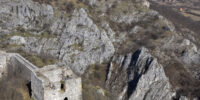The Institute of Archaeology was founded by the Committee for Scientific Institutions, University and Colleges of the People’s Republic of Serbia on May 31 1947, in Belgrade. The goal was to bring together, within a single scientific institution, all the resources from the University, from a range of museums and other scientific and professional establishments, which were, in various aspects, engaged in the study of archaeological problems and, consequently, to organise the work of archaeologists in Serbia more systematically and as well as possible. The Institute operated within the Academy of Sciences and initially had only external associates. The director was Vladimir R. Petković, his deputy – Djurdje Bošković, and the members: Miloje M. Vasić, Radoslav Grujić, Aleksandar Deroko, Lazar Mirković, Svetozar Radojčić, Miodrag Grbić, Rastislav Marić, Djordje Mano-Zisi, Mirjana Ljubinković, Radivoje Ljubinković, Ivan Zdravković and Zora Simić-Milovanović. Later that year, the following were elected: Dragoljub Jovanović, Draga and Milutin Garašanin, Milorad Panić Surep and Olga Šafarik. The Institute gained its first permanent member, the research associate Miodrag Grbić, in 1948. Then, in 1949, Nevenka Spremo became an assistant and Nadežda Rajaković (Mandić) was hired as a librarian. Milutin Garašanin, as a research associate, became a permanent member in 1950. In 1952, the assistants Vojislav Korać and Djordje Stričević were also appointed permanent members. Over the following years the number of permanent and external associates of the Institute gradually increased. Today, the Institute has several dozen permanent and about a hundred external associates, who are no longer appointed by the decree of the Ministry, as was initially the case, but are elected on the proposal of permanent associates.
In the beginning, just as it did not have permanent associates, neither did the Institute have its own premises. Some inadequate space was allocated to it in 1948 at the Residence of Princess Ljubica, but finally, in 1952, it was housed in the building of the Academy of Sciences (35, Kneza Mihaila St), where it is still located today. In February 1954, by the decision of the Serbian Academy of Sciences, the Institute started operating as an institution with its own funding and in 1961, based on a joint decision of the Executive Council of SR Serbia, the Serbian Academy of Sciences and Arts and the Faculty of Philosophy and History in Belgrade, it became an independent scientific institution.
Since its founding, the work of the Institute has persisted in several directions and has included:
- scientific work (fieldwork and desk-based study); systematic research and reconnaissance of archaeological monuments
- lectures, reports, and publications
- scientific staff advancement
- coordination of archaeological work in Serbia
- cooperation with other institutions at home and abroad.
The period of history that the Institute was supposed to address raised certain questions. Although it was more or less indisputable that the beginnings should coincide with the age of “savagery” and “barbarism”, the founders were not entirely clear about what the terminus ante quem should be. Finally, it was accepted for that to be the First Serbian Uprising, which was conditioned by both historical circumstances as well as the objective state of archaeological science at that moment in time. Namely, the time of the Turkish occupation, on the one hand, no matter how well known from the records in the Constantinople archives, needed to be archaeologically researched, while on the other hand, there were few educated archaeologists, those who specialised in prehistory and Antiquity – only two of the first 14 external associates of the Institute were schooled as archaeologists. This additionally contributed to an increased interest in mediaeval writings, architecture and painting, which would only later be transformed at the Institute into mediaeval archaeology in the true sense of the word.
The plan and programme underlined four problems that needed to be examined, i.e., four epochs characteristic for the development of material culture and life on our soil – prehistory, Antiquity, and the Early and High Middle Ages. The titles of these problems, with slight variations, would be the guideline of the Institute for almost thirty years, until the reorganisation of scientific work and life in Serbia, and hence are here quoted:
- The formation of the first communities in the Balkans, the organisation of their settlements and the creation of their cultures;
- Greek and Roman penetration into the territory of the Balkans, with particular reference to our country;
- The conflict of Byzantine culture and new trends brought to the Balkans by the Slavs;
- The stabilisation and development of Slavic and, in particular, Serbian culture in the Balkans.
Having certain authorisations to organise archaeological activity in the Republic, the Institute undertook systematic field surveys, in cooperation with other institutions, primarily museums, many of which were founded at that time. The results of these investigations were supposed to be published in the Archaeological Monuments and Sites in Serbia series in nine volumes, however, due to circumstances, only two volumes were published and the project ground to a standstill. Many years later, with the help of other relevant institutions, the Institute has taken on the task of preparing the Archaeological Map of Serbia, but progress is slow.
The results of scientific research of both permanent and external associates of the Institute, including archaeologists outside this line-up, were reported and discussed at regular meetings of the Institute and only then presented in Starinar or other publications, which guaranteed a certain scientific level of printed papers. For different reasons, however, this practice failed to be maintained. Starinar was re-launched in 1950 as a new, fourth series. Its previous publisher, the Serbian Archaeological Society, did not exist at that time, so it was natural for the Institute to take over the publication of this old archaeological journal of ours. Today, this task is still carried out by the Institute and, it can be said, quite successfully. In addition to Starinar, the Institute also publishes the Special Editions series, including a number of series dedicated to some major sites and material (Sirmium, Singidunum, Caričin Grad, Viminacium, Unpublished Prehistoric Material), which, among other things, contributed to the expansion of the Institute’s library, largely thanks to exchange, to grow from its modest beginnings comprising 174 inventory numbers in 1949 into the most important archaeological book fund in the country.
At that early stage, the main merit of the Institute was the organisation and coordination of archaeological work in Serbia and, thus, in cooperation with museums and institutes for the protection of cultural monuments, much research was initiated and the associates of the Institute took part in a large number of excavations, both those of a smaller scope as well as within major projects. The culmination was the organisation of protective works in the period between 1964 and 1971 in advance of the construction of the Djerdap 1 hydroelectric power plant on the Danube near Kladovo, where the site of Lepenski Vir was discovered, as well as hundreds of other prehistoric, antique and mediaeval sites. However, in the course of archaeological works during the construction of the Djerdap 2 hydroelectric power plant on the Danube near Kusjak, in the period between 1980 and 1984, some operational changes took place, primarily due to the constant and intensive development of archaeology as well as the inability to continue managing all of the activities from a single location and, as a result, along with the Institute, the Faculty of Philosophy and the National Museum in Belgrade became equally involved in the organisation of these works. Similarly to the intensive work in Serbia, cooperation with archaeologists from other Yugoslav republics was also established and was successfully developing during the period of the common state. On the other hand, contacts with foreign colleagues from both the East and the West were immediately established in the course of visits, lectures, study tours and participation in scientific conferences, while later, when political circumstances in the late 1960s would allow, direct cooperation with archaeological institutions was realised, whereby the Institute made connections with appropriate partners in the USA, France and Germany, which led to a joint systematic research of some of our sites, mainly from Antiquity.
In the 1970s, the automatic funding from the budget of the Ministry of Science terminated and the era of funding per projects began. At first, there were no significant differences except for perhaps somewhat more complex paperwork, but later, compliance with certain norms would be required, specifically the collection of a certain number of points, which would result in the removal of some associates less skilled in writing scientific papers from the list of those funded. The concept of archaeological projects was constantly being changed, with a tendency to frequently alternate between fragmentation and consolidation, something that has persisted to this day. During these dynamic events, in the early ’90s, the Institute of Archaeology came to the forefront of the Archaeology of Serbia macro project, which was ambitiously conceived to include all scientific institutions and to cover the entire research work in the Republic, but archaeology in Serbia, both official and unofficial, professional and amateur, proved to have assumed such proportions that not only was it impossible to control the work, but generally to have an insight into everything that was happening in archaeology and what was being discovered. The four-year and five-year projects have continued to alternate to this day, when the Institute, based on the last grant by the Ministry, now has four projects, which are independent of one another, each with its own associates, individual plan and programme, points and results, and they are:
- Archaeology of Serbia: cultural identity, integration factors, technological processes and the role of the Central Balkans in the development of European prehistory;
- Romanisation, urbanisation and transformation of urban centres of civil, military and residential character in Roman provinces in the territory of Serbia;
- The processes of urbanisation and development of mediaeval society;
- Viminacium, Roman city and legionary camp.
Finally, it can be said that despite all misfortunes that have befallen this region over the past twenty years or more, the period of chaos and absurdity, of political and economic crisis that has prevailed, with major repercussions affecting all spheres of life, including archaeology, the Institute has managed to function throughout that time, to work, research, publish, to cooperate with institutions in the country and abroad and to achieve significant and notable results.
Rastko Vasić




